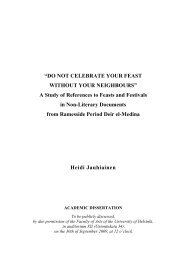BIA
bia51
bia51
Create successful ePaper yourself
Turn your PDF publications into a flip-book with our unique Google optimized e-Paper software.
AVRIL 2015<br />
onwards, indicating that it lived in or migrated<br />
through Egypt at that time.<br />
As for the argument about the colours,<br />
Migâhid said the same shades have been found<br />
in other tombs from the Fourth Dynasty and<br />
later from the Old Kingdom. For instance, the<br />
orange shade was used in the tomb of Queen<br />
Mersyankh III in the eastern cemetery on the<br />
Gîza Plateau, he said.<br />
Inside the offertory chapel of the queen’s<br />
tomb a scene with a procession of geese was<br />
represented, he said, and one of them had an<br />
orange beak in the same style as one of the<br />
Maydûm Geese.<br />
Concerning the size of the geese and<br />
manner in which they were drawn, something<br />
which in TIRADRITTI’s opinion was unusual,<br />
Migâhid said that this was another false<br />
argument. “Comparing this feature to the<br />
cranes and geese depicted in the tomb of<br />
Mersyankh III, we can see the birds are the<br />
same size in this scene,” Migâhid said. He<br />
added that it was usual in Old Kingdom tombs<br />
for geese depicted in the same scene to be<br />
shown the same size.<br />
TIRADRITTI had claimed that the scene was<br />
painted over another painting, which was why<br />
the background had different colours in some<br />
places, he said. However, no traces of the<br />
supposed older scene can be seen, Migâhid<br />
said, and TIRADRITTI had not said what kind of<br />
scene the older one could be. A difference in<br />
background colour might also have been the<br />
result of older restoration.<br />
“Not mentioning anything about the scene<br />
does not mean that VASSALLI faked the Maydûm<br />
Geese painting, as TIRADRITTI claims,” Migâhid<br />
told the Weekly, adding that notes of the<br />
discovery had also been kept by VASSALLI’s<br />
colleagues.<br />
According to Albert DANINOS, the deputy of<br />
Egyptologist Auguste MARIETTE at the time,<br />
VASSALLI had moved the Maydûm Geese painting<br />
from the tomb’s corridor “with marvellous<br />
patience and care.” PETRIE, another<br />
contemporary who was not an admirer of his<br />
colleagues, claimed that VASSALLI had “hacked<br />
away much of the fresco” to remove the<br />
painting.<br />
It is known from MARIETTE’s records of the<br />
Maydûm excavation in 1871 that the work was<br />
not always carefully done, since much of his<br />
attention was given to the mastaba of Rahotep<br />
and Nefret where he found the two famous<br />
statues of the owners of the tomb that are<br />
today in the Egyptian Museum in Cairo.<br />
TIRADRITTI also mentioned another painting,<br />
which in his view could have been done by<br />
VASSALLI. This is a fragment depicting the<br />
remains of two hieroglyphic letters, a basket<br />
with a handle that represents the hieroglyph K<br />
and a vulture that represents the hieroglyph A.<br />
TIRADRITTI said that these two signs were<br />
intended as a reference to VASSALLI’s second<br />
wife Gigliati ANGIOLA.<br />
However, Migâhid said that if the context of<br />
the tomb was studied it would be clear that<br />
these two signs were perhaps the remains of<br />
the names of Nefermaat and Atet’s son Serfka.<br />
The names appear in the tomb a number of<br />
times.<br />
“Moreover, the scene of the Maydûm Geese<br />
and the hieroglyphs come from the north wall<br />
of the east corridor inside the chapel of Atet,<br />
where a large figure of Serfka was depicted<br />
standing and catching birds amid an<br />
agricultural scene,” Migâhid said.<br />
It should also not be forgotten that when<br />
VASSALLI removed the painting of the Maydûm<br />
Geese from the north wall of the corridor, he<br />
cut into the scenes above and below the<br />
painting to make sure that the geese would<br />
not be damaged during this process, he said.<br />
Therefore, traces of feet, a hand and the<br />
top of a hieroglyph were preserved on the<br />
outside edges of the panel. “The rest of the<br />
wall decoration was affected by this action,” he<br />
said.<br />
Migâhid said that the tomb of Nefermaat,<br />
the son of the pharaoh Huni and his wife Atet,<br />
was the largest known tomb from the Old<br />
Kingdom, and Nefermaat was the earliest<br />
known Egyptian vizier to be attested.<br />
As a result, scholars should be careful<br />
about doubting one of the most beautiful<br />
ancient Egyptian works of art and should take<br />
into consideration the wider context of the<br />
<strong>BIA</strong> LI — Janvier/Juin 2015 84



